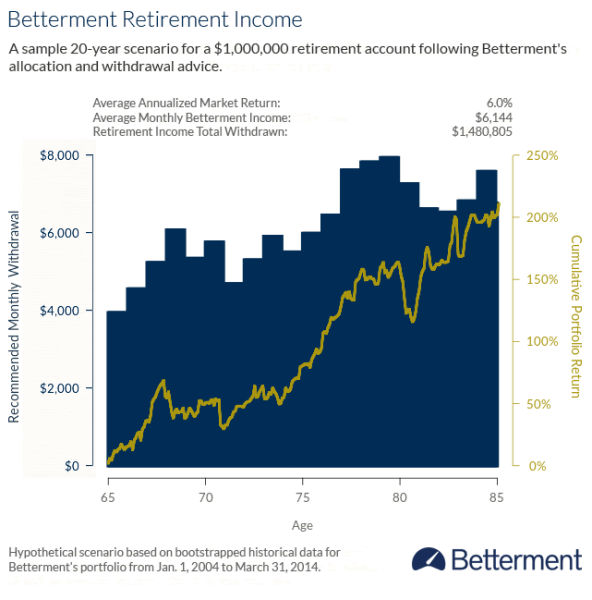 Online portfolio manager Betterment recently rolled out a new Retirement Income feature that will help you withdraw money from your nest egg. Unfortunately, even though I have a Betterment account I couldn’t test it out directly as it is currently only available to customers with a $100,000+ balance that have designated themselves as retired. But through a combination of reading through their website materials, press releases, blog posts, as well as asking an employee specific questions, I was able to get a good idea of how this feature works.
Online portfolio manager Betterment recently rolled out a new Retirement Income feature that will help you withdraw money from your nest egg. Unfortunately, even though I have a Betterment account I couldn’t test it out directly as it is currently only available to customers with a $100,000+ balance that have designated themselves as retired. But through a combination of reading through their website materials, press releases, blog posts, as well as asking an employee specific questions, I was able to get a good idea of how this feature works.
Factors taken in account. Here’s what they ask about your individual situation:
- Current portfolio value. You can add outside accounts manually.
- Asset allocation (Betterment portfolios are built-in).
- Inflation is assumed to be 3% annually.
- Time horizon (age and entered longevity).
Dynamic withdrawal strategy. This is very important! Betterment’s calculations assume a dynamic strategy where you come back every year to and reassess to determine a new safe withdrawal amount. Dynamic strategies are more flexible and resilient than static strategies which simply set a number at the beginning of retirement and stick with it regardless of portfolio performance. However, as a result you’ll have to deal with varying income, and it does not appear that they perform income smoothing. Here is an example scenario of how income might fluctuate with (rather optimistic) market performance (source):

If you follow their advice, updating at least annually, Betterment estimates that there is a 1% or less chance of depleting your portfolio before the end of your designated time horizon. As with many similar calculators in the industry, their numbers are based on Monte Carlo simulations.
Sample numbers for 65-year old retiree. I asked Betterment Marketing Manager Katherine Buck about the following hypothetical situation: $1,000,000 portfolio, 60% stocks and 40% bonds invested at Betterment, with 30-year time horizon (age 65 to 95). In that case, the current model income recommendation would be $2,879 per month ($34,548 a year), or roughly 3.45% of the $1M portfolio.
Automatic withdrawals. To recreate a paycheck in retirement, you can set up an auto-withdrawal to deposit money into your linked bank account on a regular basis. You can go with their recommended amount, or you can adjust the amount as you wish.
Cost. The Retirement Income feature is included in their existing fee structure. At a $100,000 minimum balance, a Betterment charges 0.15% annually and that fee is inclusive of all trading costs and rebalancing costs. 0.15% works out to $150 a year per $100,000 invested. So a $1,000,000 portfolio would cost $1,500 a year. This is much cheaper than a traditional advisor from a major brokerage firm.
Overall, I think this is a smart move on Betterment’s part to start offering more features that a human financial advisor would offer that a discount brokerage like TD Ameritrade wouldn’t. The numbers appear to be reasonably conservative and the tool is definitely easy to use. A competing product that I’ve also written about is the Vanguard Managed Payout fund. In comparison with that product, I wonder if Betterment shouldn’t add a smoothing component to their recommended income amounts so that the withdrawal amounts don’t swing too wildly from year-to-year. Betterment has historically shown a good willingness to make changes in response to feedback, so I am hopeful they will consider it.
Also see my previous full Betterment review.
 The Best Credit Card Bonus Offers – 2025
The Best Credit Card Bonus Offers – 2025 Big List of Free Stocks from Brokerage Apps
Big List of Free Stocks from Brokerage Apps Best Interest Rates on Cash - 2025
Best Interest Rates on Cash - 2025 Free Credit Scores x 3 + Free Credit Monitoring
Free Credit Scores x 3 + Free Credit Monitoring Best No Fee 0% APR Balance Transfer Offers
Best No Fee 0% APR Balance Transfer Offers Little-Known Cellular Data Plans That Can Save Big Money
Little-Known Cellular Data Plans That Can Save Big Money How To Haggle Your Cable or Direct TV Bill
How To Haggle Your Cable or Direct TV Bill Big List of Free Consumer Data Reports (Credit, Rent, Work)
Big List of Free Consumer Data Reports (Credit, Rent, Work)
Does Betterment have an “Annuities” comparison or do they simply ignore that possibility given that it’s not really their business model?
Also, are they trying to clear you bank account or have you die with money? Their sample numbers seems to have you simply breaking out the money over 30 years with basically zero returns above inflation.
This may or may not be an accurate reflection of reality. But $35k / year of income after a lifetime of saving up to $1M is not really an encouraging retirement outlook 🙁
I agree with Gates. $35K per year is just interest/dividends you collect from your $1M. So, then your children inherit that $1M. Actually, it would be more than that. On average, your account would double every 7 years. So, your children will inherit several million and would never have to work.
I would agree 3.5% is a pretty low withdrawal rate for a 65-year-old, but living to age 95 and a 99% confidence rate is also a pretty high hurdle. I don’t know exactly how they came up with their numbers but I’d say in the current low dividend yield, low inflation, and low interest rate environment, maybe 3.5% nominal is about right. If the market goes up, then you can withdraw more in future years since it is a dynamic model.
Perhaps it would be better to be able to say choose a 95% confidence rate and just know that there is a slightly greater chance that you might run into a rough patch and have to cut back on withdrawals.
Ouch, my ears!
Didn’t realize my sound was all the way up when I visited mymoneyblog. Darned autoplay video! Could you include a link to it instead?
Same issue….didn’t know that it will start auto playing. May be site is being reimbursed for number of plays or may be it’s a bug. I admire the author of this website but such a video is annoying. A paused version would be a good idea.
Apologies for the auto-play. I didn’t notice that issue because I have a plugin that automatically disables anything Flash unless I manually enable it (FlashBlock for Chrome, it is great and saves on computer resources). I think I figured out how to disable the auto-play function. Nope, I don’t get compensated no matter if there are a million plays.